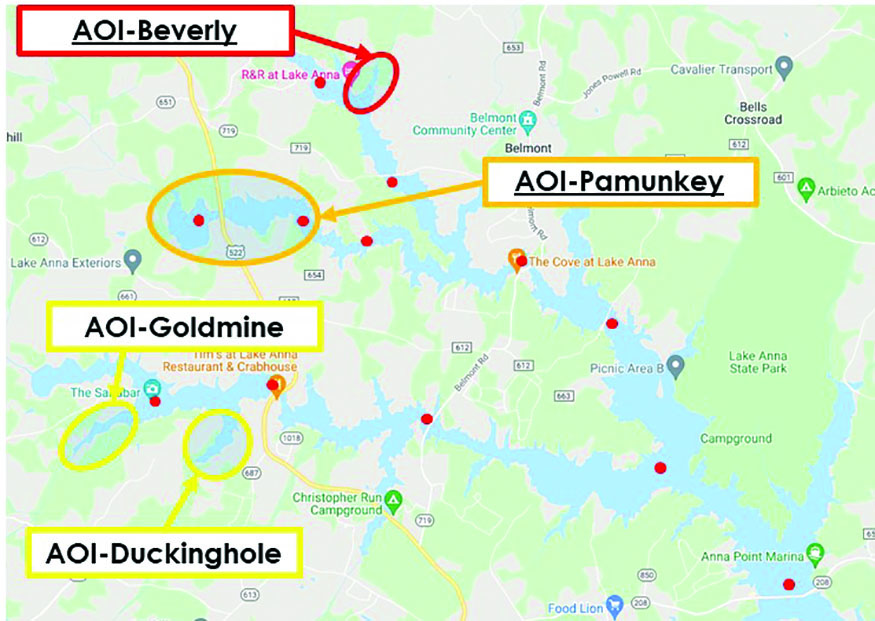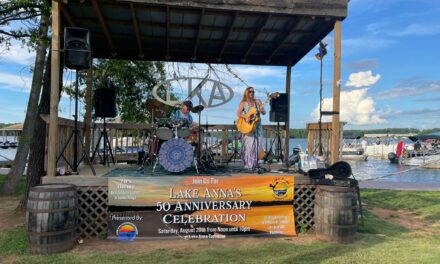The Lake Anna Civic Association (LACA) has announced a plan to treat algae blooms in three areas of the headwaters of Lake Anna with a hydrogen peroxide algaecide.
“LACA has been at the forefront on HAB at Lake Anna. We have expanded our cyanobacteria testing, worked with DEQ and VDH and have hosted several HAB stakeholder meetings over the past two years. Our members are upset and want results, not more testing and studies. With that in mind, we have rolled out the Kick the HAB campaign. This campaign is a ‘proof of concept that we can take action on four small areas of interest on the lake with the goal of eliminating the VDH recreational no-swim advisories in these areas. If successful, we have a roadmap on how to mitigate HAB on Lake Anna. Please help support this effort by making a tax-deductible contribution to Kick the HAB at lakeannavirginia.org,” LACA president Greg Baker told Life & Times recently.
Baker said BlueGreen Water Technology has received final approvals from the Virginia Department of Agriculture and Consumer Services for the use of Lake Guard Oxy algaecide.
With this approval and Dominion Energy’s permission, LACA is moving forward with the first application of Lake Guard Oxy the week of June 20 to the first Area of Interest (AOI) on Lake Anna.
The Cyanobacteria Mitigation Program (CMP) was previously shared with the three counties surrounding Lake Anna through the Lake Anna Advisory Committee on May 25th.
LACA solicited RFQs from several licensed contractors to apply Lake Guard Oxy and has chosen SOLitude Lake Management to apply Lake Guard Oxy to four areas of interest: June 16-17 upper Pamunkey Branch, July 14 or 18 Duckinghole and Goldmine Creeks/North Anna, July 15 or 19 Pamunkey Branch/Beverly Cove, August 11 or 15 Duckinghole and Goldmine Creeks, August 12 or 16 Pamunkey Branch/Beverly Cove.
Schedules are tentative based on lake and weather conditions and LACA will keep their website updated with current dates and times for each application as the summer progresses.
Baker noted the CMP has been in the making for months and is the result of many hundreds of volunteer hours with the goal of eliminating Virginia Department of Health Recreational (No-Swim) Advisories in the AOIs. It is a pilot program (proof of concept) made up of three pillars including (1) Planning & Resourcing, (2) Mitigation and (3) Monitoring. For more information, please visit www.lakeannavirginia.org/KicktheHAB.
Baker presented the plan to the Lake Anna Advisory Committee at its May meeting. While no action was asked to be taken by the LAAC, members expressed interest in the plan to use algaecide.
“While I cannot speak for others on the committee, I would say we all can agree that any time anyone wants to treat the lake with any chemical, we need to carefully understand the goals and effects of such efforts. I have personally looked into the use of algaecides on other waters around the country and did not find any reason to oppose this experimental treatment,” noted LAAC Chairman C.C. McCotter. He added: “While this treatment might eliminate algae blooms in the area of treatment short term, the long term causes of our harmful algae blooms need to be addressed and mitigated. LAAC and Dominion Energy have each expressed support of planting native vegetation in the headwaters of the lake to absorb the excessive amounts of phosphorus and nitrogen entering the lake via the watershed.”
BlueGreen Water Technology has been using Lake Guard Oxy to successfully eliminate algae in waters around the country including Florida and Ohio with no discernable negative effects on native plants, zooplankton, fish and other aquatic residents of the ecosystems they treat.
Lake Anna has experienced harmful algae blooms as documented by the Virginia Department Environmental Quality and the Virginia Department of Health. Starting in late June/early July levels of microcystin toxins released when algae blooms have reached thresholds that trigger VHD issued HAB advisories.
The advisories warn lake users to avoid swimming in the affected areas which could lead to skin irritation, inhalation/respiratory issues and other allergic reactions. The advisories, have in the past years, lasted through September in the upper portion of the lake (North Anna, Pamunkey Branch and Terry’s Run). The furthest down the advisories have reached is at the Lake Anna State Park.
Kicking The HABs This Summer




















